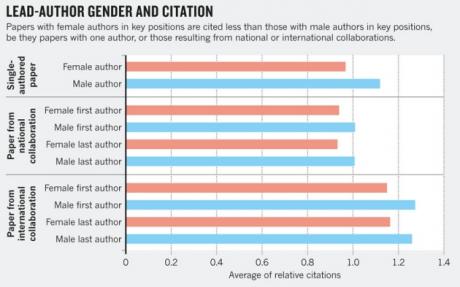New paper on “Global gender disparities in science”
There is an interesting new paper in Nature of interest. The paper is titled “Bibliometrics: Global gender disparities in science” and is by Vincent Larivière, Chaoqun Ni, Yves Gingras, Blaise Cronin & Cassidy R. Sugimoto. In the paper the authors report a detailed analysis three parameters:
- authorship of published scientific papers (which they use as a surrogate for research output)
- co-authorship on papers (which they use as a surrogate for collaboration)
- citations (which they use as a surrogate for scientific impact)
They then assigned gender to authors using multiple sources and examined the relationships between the 3 listed parameters and gender. And the findings are pretty striking.
I note – it is worth going to the Nature web cite for this article because some of the figures are interactive and one can click on different fields and change the plots.
The authors state – before digging into the details of their analysis “In our view, the scale of this study provides much-needed empirical evidence of the inequality that is still all too pervasive in science. It should serve as a call to action for the development of higher education and science policy.” A pretty strong statement that at least to me seems to be worth considering given their analysis.
Among their findings
- Globally men make up > 70% of the “fractionalized authorships” of scientific papers.
- Countries in S. America and E. Europe have somewhat better (on average) gender equity in authorship
- As shown previously, the gender ratio varies enormously between fields
- In terms of collaboration women tended to be more “domestically oriented” (i.e., focused on within country collaborations) than men.
- And the finding getting the most press — papers for which a woman had a prominent author position received fewer citations (on average) than those in which a man had such prominent position.
The authors then discuss the implications of their findings and make some recommendations for future actions. Among their conclusions (which I quote directly so as to not alter any implied meaning):
- “barriers to women in science remain widespread worldwide, despite more than a decade of policies aimed at levelling the playing field”
- “programmes fostering international collaboration for female researchers might help to level the playing field”
- “Any realistic policy to enhance women’s participation in the scientific workforce must take into account the variety of social, cultural, economic and political contexts in which students learn science and scientific work is performed”
This paper is definitely worth looking at in detail. And I note there is also a lot of supplemental material that might be worth downloading and playing around with. Data is critical for understanding the gender disparities in science and for planning and then testing ways to correct such disparities.





Comments
Post new comment